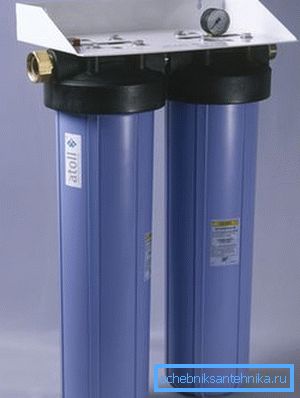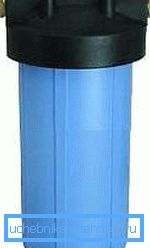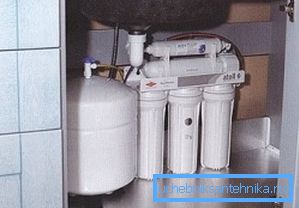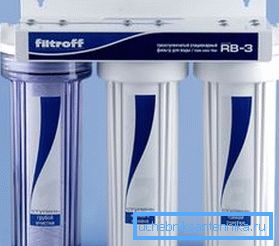Filter under the sink: selection, flow and storage models
Sometimes the quality of water supplied to the population through a centralized water supply system or extracted in an autonomous way in the private sector leaves much to be desired, therefore, for its purification a filter is installed under the sink or in some other place.
But installing such a cleaning device at a home pumping station or at a water distribution unit in an apartment is usually done during pipe installation and wiring, and if the need arises after that, then the best place to install is a cabinet or cupboard on which the kitchen sink is installed. In more detail about all this below, and in the help you can watch demonstration of video in this article.

Flow filters
What are they needed for

- It is unlikely for someone to be the news that the water used for domestic purposes may be unsuitable not only for food consumption, but even for washing, as the rust there leaves leaves yellow-brown stains on linen. In addition to rust, there may be bacteria, for the destruction of which chlorine is used on water canals, but again, such water is extremely unpleasant to taste. In addition, there is formalin and formaldehyde, which can cause malignant tumors, even with a slight intake of these substances into the human body.
- In addition, water may contain fluoride compounds, which are added as a preventive measure, but can cause caries and contribute to the development of arthritis and other bone diseases.. In addition, phthalic acid ester (phthalates) or other chemicals that adversely affect the health of the human body may be in the water you consume.
Note. All of the above reasons suggest that you may need to install a water filter under the sink, but first you need to choose what we will discuss below.
Filter selection

| Flow food filters | |||
| The simplest | Medium cleaning | Fine cleaning | |
| Jug, nozzles on the crane | 2-step with one flask or 3-step with two flasks | Flowing with ultraviolet membrane. Flow-through or cumulative reverse osmosis | |
| Flow-through (sedimentary) filters for mechanical cleaning or main flow-through | |||
| Cartridge type | Mesh (mesh inserted into the housing) | ||
| Water enters through foamed or filament polypropylene. All impurities are trapped on the outside of the cartridge, which cannot be cleaned - it is designed for one-time use (refers to fine filters). However, the degree of purification is determined by the porosity of the material on the installed cartridge and can be from 10 to 100 microns. | By degree of cleaning | By washing method | According to the method of connecting to the pipeline |
| Rough cleaning (sump). In these cases, the grid is up to 300 μm, and for fine cleaning the grid is up to 5 μm. | Industrial self-washing and non-washing | Threaded and flanged pipe connection |
Filter capability table
Pay attention to the table above and you will see which water filter for washing is better in your case, that is, you just need to determine the degree of cleaning.
For example, if in a well or a well water is simply silted and you do not have the opportunity to clean the source, then installing a flow cleaning device for mechanical cleaning is sufficient, but if there are any chemical elements there, then you will need fine-cleaning cartridges with a mesh of up to 5 microns .
But it may be that the water needs to be cleaned not only from various sedimentary suspensions (silt, sand, rust), but also from chemical formations (fluoride compounds, phthalic acid, etc.) - in such cases you can arrange two filters for water purification under the sink.
The first in such situations is to install a mechanical cleaner for tap water, which will collect all the solid particles, ranging in size from 10 microns and above, as well as up to 80% of chlorine, and after that you install fine cleaning and get normal drinking water at the outlet.

When choosing a cartridge or mesh for mechanical screening of impurities, the best filter for water under the sink will hold up suspensions and formations of 10 microns and here you will not have to choose very long - there are very few such devices. It will be much more difficult to choose a device for removing harmful chemicals, since a certain model is calculated on certain formations.
If you get water from the centralized utility networks, then you can contact your local Vodokanal for information on the composition of the water - you must provide it. But if you have autonomous support, you will have to seek help from the local sanitary and epidemiological station (sanitary and epidemiological station) in order for them to carry out chemical analysis - this is also their responsibility. As a rule, downhole production of water carries less unnecessary impurities than well.

Continuing the theme, what kind of water filter to choose under the sink, it should be said that the degree of protection can be increased by increasing the number of flasks or steps, for example, a device with two flasks. The first mechanical cartridge holds particles of 10-30 microns in size, and the second flask contains a carbon (powder or granular activated carbon) post-treatment cartridge.
Such a device will relieve drinking water not only from mechanical impurities, but also from organochlorine formations and partially from oil products, heavy metals, iron, manganese, pesticides and the like.

In the upper photo, you see an improved device with three flasks (its price is higher), each of which represents an intermediate screening rate for various unnecessary impurities:
- A mechanical cartridge (P-5) is installed, which is able to trap particles as small as 5-10 microns.
- Installed coal cartridge, which eliminates organochlorine compounds. Type GAC-10 contains granulated coal, and EPM-10 - pressed coal. Thus, the SGAC model is impregnated with silver, and hexametaphosphate crystals are added to TSGAC.
- Ion exchange cartridge for water softening by removing salts. For example, CBR2-10 retains particles of 0.5 microns, and this lead and chlorine.
Note. For a three-stage cleaning instruction allows you to install devices not only with three, but with two flasks. So, in the second case, the first cartridge performs the function of the first two stages.
Conclusion
By and large, installing a water filter under the sink is done without any difficulty — the device simply crashes into the supply pipe, like any other faucet or fitting. As you probably understood from the above material, the difficulty is the very selection of the desired cartridge, which will capture exactly the impurities that are in your source.